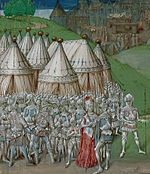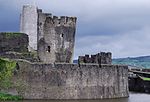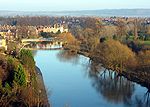- Despenser War
-
Despenser War Date 1321-1322 Location Glamorgan, Wales and northern England Result Royalist victory Belligerents Kingdom of England Marcher Lords Commanders and leaders Edward II of England
Hugh Despenser the Elder
Hugh Despenser the YoungerRoger Mortimer, Baron Mortimer
Thomas, 2nd Earl of Lancaster
Humphrey de Bohun, 4th Earl of HerefordStrength Royalist Army (12,000) over 1,000; less than 12,000 The Despenser War was a baronial revolt between 1321-2 led by the Marcher Lords Roger Mortimer, Baron Mortimer and Humphrey de Bohun, 4th Earl of Hereford against Edward II of England and his favourite, Hugh Despenser the Younger.[nb 1] After success during the summer of 1321, Edward was able to take advantage of a temporary peace to rally more support, leading to a successful winter campaign in southern Wales and the royal victory at the battle of Boroughbridge in the north of England in March 1322. The war paved the way for Edward's increasingly harsh rule during the mid-1320s and his fall from power in 1326.
Contents
Causes of the war
The Lords Ordainers, the powerful baronial hegemony led by Thomas, 2nd Earl of Lancaster despised Hugh Despenser the younger, the Lord of Glamorgan, and the latter's father Hugh le Despenser, 1st Earl of Winchester on account of the influence they both wielded over King Edward II of England. The council of Ordainers was formed in 1311 to reform the King's household, restrict his royal prerogatives, supervise the economy, and they insisted on the banishment of his then favourite, Piers Gaveston.
Marcher Lords Roger Mortimer, Baron Mortimer, his uncle, Roger Mortimer de Chirk, and Humphrey de Bohun, 4th Earl of Hereford (a staunch Ordainer) were also avowed enemies of the Despensers. The younger Despenser, through his marriage with Eleanor de Clare, eldest sister of the wealthy noble Gilbert de Clare, 8th Earl of Hertford, received many expensive gifts, and much property and land grants in the Marcher territory. When Hertford was killed at the Battle of Bannockburn in 1314, Despenser took most of the vast de Clare inheritance for himself, including almost all of Glamorgan, despite Eleanor having had two other sisters, who were co-heiresses to their childless brother.[1] This angered his brothers-in-law, Roger d'Amory and Hugh de Audley, who were cheated out of their share of lands which rightfully belonged to them. Hostility deepened among the Marcher Lords when Despenser titled himself "Lord of Glamorgan" and "Earl of Gloucester".[2]
First phase: February-August 1321
In February 1321 Mortimer, Hereford and Lancaster agreed on an attack on the Despenser lands in Wales.[3] Edward responded in March by mobilising his forces in Wales, demonstrating that he intended to make any attack on the Despensers an attack on the crown, and therefore treasonable.[4] The king travelled to Gloucester and called upon the Marcher Lords to join him there; Mortimer and Hereford declined.[5] Mobilising more forces, Edward marched on to Bristol, and repeated his call for the Marcher Lords to convene with him there in May.[6] They again declined.[7]
Mortimer and Hereford promptly began their attack on the Despenser lands.[8] Newport, Cardiff and Caerphilly were seized by Mortimer in an intense eight day campaign.[9] Mortimer and Hereford then set about pillaging Glamorgan and Gloucestershire, before marching north to join Lancaster at Pontefract.[10] The barons then swore an alliance at Sherburn-in-Elmet in June, naming their faction the "contrariants" and promising to remove the Despensers for good.[11]
Edward had returned to London, where he held his own parliament to discuss courses of action.[12] Mortimer led his army east towards London as well, reaching St Albans in late July.[13] The city of London refused to let Mortimer's forces in, and his forces placed the capital under effective siege.[14] Lancaster arrived in August to support him and a tense stand-off ensued, with the younger Despenser threatening the rebels from a ship on the River Thames, and the barons threatening to begin to destroy royal properties and lands outside London unless he desisted.[15]
The Earl of Pembroke, a moderate baron with strong French links, intervened in an attempt to defuse the crisis.[16] Edward continued to refuse to negotiate or exile the Despensers, so Pembroke arranged for Queen Isabella to publicly go down on her knees to appeal to Edward to exile the Despensers.[17] This provided him with a face-saving excuse to exile the Despensers and defuse the crisis, but it was clear Edward intended to arrange their return at the first opportunity.[18]
Second phase: October 1321-March 1322
Despite the momentary respite, by the autumn of 1321 the tensions between Edward and the baronial opposition led by Thomas of Lancaster, were extremely high, with both sides retaining mobilised forces across the country.[19] At this point, Isabella undertook a pilgrimage to Canterbury, during which she left the traditional route to stop at Leeds Castle, a fortification held by Bartholomew de Badlesmere, steward of the King's household who had by 1321 joined the ranks of Edward's opponents. Historians believe that the pilgrimage was a deliberate act by Isabella on Edward's behalf to create a casus belli.[20] Lord Badlesmere was away at the time, having left his wife Margaret in charge of the castle. When the latter adamantly refused the Queen admittance, fighting broke out outside the castle between Isabella's guards and the garrison.[21]
Edward mobilised his own faction and placed Leeds castle under siege, giving Isabella the Great Seal and control of the royal Chancery.[21]The attack on Isabella increased Edward's popular support; the moderate barons moved to support him, as did many volunteers from London.[22] Before long, chroniclers record that Edward had an army of 30,000 men besieging Leeds castle, although this may represent an overestimate.[23] The castle surrendered at the end of October and Edward took a vicious revenge on the constable and his men.[24] Edward's position was now much stronger than in August and he set about revoking the banishment order on the Despensers.[25]
Mortimer and Hereford travelled north to discuss the situation with Lancaster, and the three reaffirmed their intent to oppose Edward.[26] Back in the Welsh borders, however, there was an uprising of the local peasantry, and Mortimer and Hereford were forced to return south to deal with the problem.[27] Edward marched to Cirencester in December, preparing to invade the Welsh borders.[28] In the north, Lancaster was attempting to enlist the support of the Scots in a bid to bring more forces to bear before Edward could retake south Wales.[29] In January 1322 Edward finally overcame the resistance along the Severn River and advanced into the Welsh Marches; the situation was now impossible and Roger Mortimer and his uncle, Roger Mortimer de Chirk surrendered to the King at Shrewsbury on 22 January 1322.[30]
Edward turned north, assisted by the Despensers who had secretly returned from exile in mid-January.[31] Edward mustered his men at Coventry in February and engaged Lancaster and his forces at the Battle of Boroughbridge on 16 March.[32] Edward was victorious. Captured after the battle, Lancaster was promptly executed, leaving Edward and the Despensers firmly in control of England and the Welsh Marches.[33]
Aftermath of the Despenser War
 A 14th-century manuscript illustration showing Queen Isabella and Roger Mortimer, Baron Mortimer. The execution of Hugh Despenser the Younger can be seen in the background
A 14th-century manuscript illustration showing Queen Isabella and Roger Mortimer, Baron Mortimer. The execution of Hugh Despenser the Younger can be seen in the background
The Despenser War "totally changed the political scene in England".[34] Edward's victory provided the catalyst for the disintegration of the baronial oligarchy giving the King the opportunity to resume the regal powers the Ordainers had denied him since they presented their Ordinances to him in 1311.[35]
Roger Mortimer was imprisoned in the Tower of London after his surrender at Shrewsbury. In August 1323 he escaped to France where he later joined Queen Isabella, who was ostensibly on a peace mission, but was actually seeking assistance from her brother, King Charles IV of France to oust the Despensers. Mortimer and Isabella obtained the necessary help in Flanders and in 1326 the successful Invasion of England was launched.
This invasion led to the executions of the two Despensers, the deposition and killing of Edward II, and the seizure of authority by Queen Isabella and Roger Mortimer, who became the de facto rulers of England from 1327 to 1330. Mortimer was hanged, drawn and quartered in November 1330 by the order of Isabella's son King Edward III after he ousted his mother and Mortimer from power and assumed personal rule.
Notes
- ^ Some historians use the label the "Despenser War" to refer to just the second phase of the conflict; others apply it to the entirety of the conflict. Others prefer the term the "Despenser Wars". The Welsh part of the campaign is occasionally termed the "Glamorgan war".
References
- ^ Costain, pp.189-91
- ^ Costain, pp.189-91
- ^ Weir, p.129.
- ^ Weir, p.129.
- ^ Weir, p.129.
- ^ Weir, p.130.
- ^ Weir, p.130.
- ^ Weir, p.130.
- ^ Weir, p.130.
- ^ Weir, p.130.
- ^ Weir, p.130.
- ^ Weir, p.131.
- ^ Weir, p.131.
- ^ Weir, p.131.
- ^ Weir, p.131.
- ^ Weir, p.132.
- ^ Weir, p.132.
- ^ Doherty, p.67; Weir 2006, p.132.
- ^ Doherty, p.70.
- ^ Doherty, p.70-1; Weir 2006, p.133.
- ^ a b Doherty, p.71.
- ^ Weir, p.135.
- ^ Weir, p.135.
- ^ Weir, p.135.
- ^ Weir, p.136.
- ^ Weir, p.136.
- ^ Weir, p.136.
- ^ Weir, p.136.
- ^ Weir, p.137.
- ^ Costain, pp.196-97
- ^ Weir, p.138.
- ^ Weir, p.139.
- ^ Doherty, pp72-3.
- ^ Mortimer, p.32.
- ^ Costain, pp.193-97
Bibliography
- Costain, Thomas Bertam. (1962) The Three Edwards. London: Doubleday.
- Doherty, P.C. (2003) Isabella and the Strange Death of Edward II. London: Robinson. ISBN 1841198439.
- Mortimer, Ian. (2008) The Perfect King: The Life of Edward III, Father of the English Nation. London: Vintage Books. ISBN 9780099527091.
- Weir, Alison. (2006) Queen Isabella: She-Wolf of France, Queen of England. London: Pimlico Books. ISBN 9780712641944.
Categories:- 1321 in Europe
- 1321 in politics
- 14th century in Wales
- Military history of Wales
- History of Glamorgan
Wikimedia Foundation. 2010.



